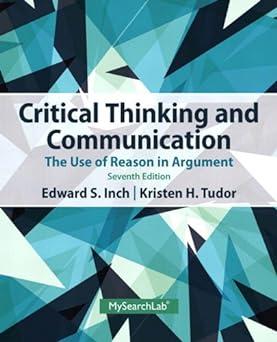Driving with Cell Phones. Read the following persuasive appeal by the National Highway Transportation Safety Administration. The
Question:
Driving with Cell Phones. Read the following persuasive appeal by the National Highway Transportation Safety Administration. The evidence presented in this document provides support for banning mobile telephone use in vehicles. Read the argument and do the following:
1. Identify the types of evidence used.
2. Assess the quality of the evidence.
Using a Cell Phone While Driving is Dangerous A growing body of research suggests that using a cell phone while driving is a serious safety problem—even if a driver’s hands are on the steering wheel. . . .
With 2,600 highway deaths and 330,000 injuries per year linked to cell phone use, according to a recent Harvard University study, the search for ways to mitigate distracted driving is becoming urgent. . . . Automakers are loading up vehicles with ever-more sophisticated technologies—such as screen-based navigation systems, dashboard entertainment consoles, and MP3 players—challenging engineers with how to continue the business boom without further compromising safety.
Automakers have made a huge bet that hands-free technology would be the answer.
Services such as OnStar from General Motors Corp. let customers make calls over a voiceactivated in-car cell phone, talk to an operator to get directions, or even consult with a concierge for shopping or restaurant recommendations. . . .
But the latest research shows people talking on cell phones are distracted even if their hands remain on the steering wheel. The National Highway Traffic Safety Administration
(NHTSA) is currently conducting in-depth research at its National Advanced Driving Simulator, run jointly with the University of Iowa. Preliminary research released last month indicates clear trade-offs with hands-free technology. Even though their hands remained on the wheel, study subjects using voice-activated systems take longer to dial—a potentially dangerous distraction . . . .
“The distraction risks associated with cell phone use do not diminish with hands-free devices,” said Rae Tyson, spokesman for NHTSA.
To the extent that hands-free technology gives drivers a false sense of security and prods them to engage in longer phone conversations, it may even exacerbate the safety problem, Tyson said. . . .
Despite the safety concerns, customers’ desire to stay connected to the outside world is only expected to increase. With some 163 million cell phone subscribers in the United States, NHTSA estimates that 3 percent of U.S. drivers are talking on cell phones at any given time.
A 2003 study by the Harvard Center for Risk Analysis suggested a very real safety problem exists when drivers are paired with cell phones.
The study found an estimated 2,600 deaths a year could be linked to cell phone use.
Cell phone use also is connected to approximately 330,000 moderate to critical injuries annually and 1.5 million instances of property damage a year, the study found.
But the Harvard researchers wanted to quantify the potential cost, measured in lost productivity, of banning cell phone use in cars. They concluded that taking cell phones away from drivers would cost $43 billion a year in lost economic activity—about the same economic value of the lost lives and injuries.
“It’s like cars themselves,” said Joshua Cohen, co-author of the study. “Cars kill 40,000 people a year. That translates into a one in a 100 chance that a child born today will eventually die in a car crash. Yet we still have cars. Why? Because they are very useful. . . .”
Step by Step Answer:

Critical Thinking And Communication The Use Of Reason In Argument
ISBN: 9780205925773
7th Edition
Authors: Edward S. Inch, Kristen H. Tudor






